Content of this article
- What is an Artificial Climbing Wall?
- Climbing Wall Anatomy
- Types of Artificial Rock Climbing Wall
- Fundamentals of Artificial Rock Climbing Wall
- Various Types of Climbing Wall
- Size Possibilities of a climbing wall
- Climbing Wall as a tourist attraction
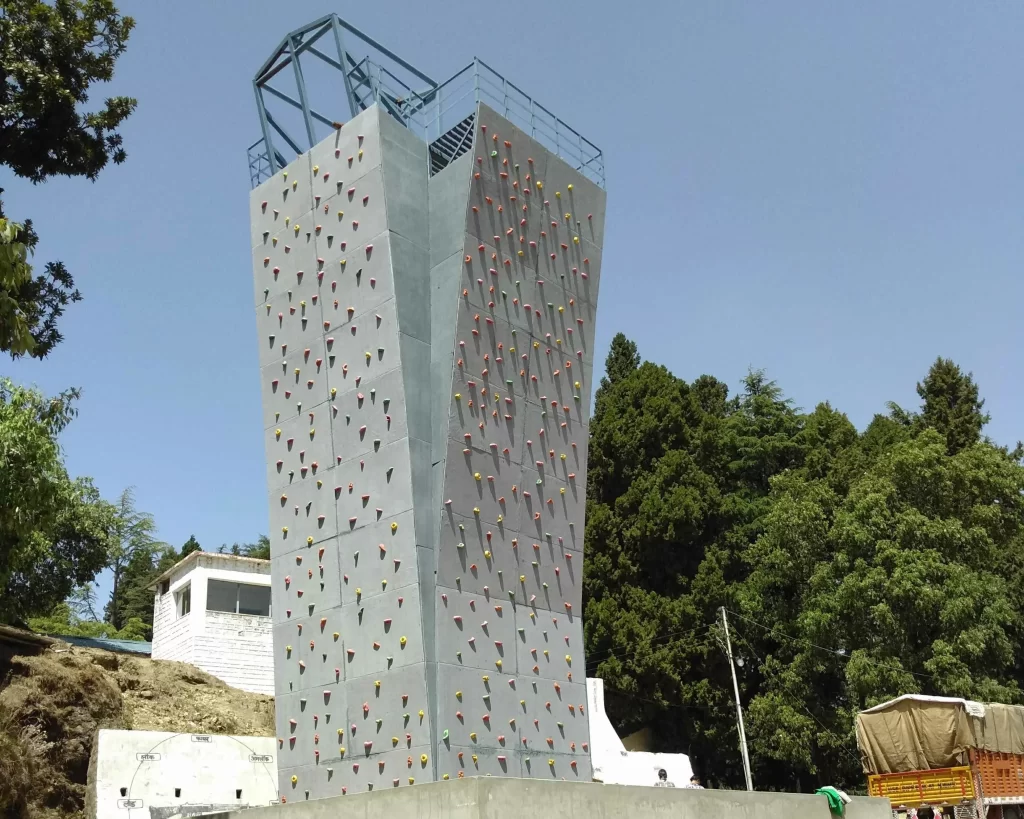
What is an Artificial Climbing Wall?
An artificial rock-climbing wall is a structure that simulates a natural rock face for rock climbing. It is man-made and can be composed of different materials such as concrete, plastic, metal, wood or fiberglass (FRP). Most common material used for building a climbing wall support structure is Mild Steel and for manufacturing climbing wall panels, is FRP.
Climbing Wall Anatomy
When looking at an artificial rock-climbing wall, it is essential to understand the different parts that make it up and how they work. The following is a breakdown of the anatomy of an artificial climbing wall:
- Base / foundation: The base or foundation of the climbing wall is typically made out of concrete, and it serves as the foundation for the other parts of the wall. An attached climbing wall might not need a foundation to be made. In some cases, a pile foundation might also be considered for supporting a climbing wall structure.
- Footing: The footing climbers stand on while ascending or descending the wall. It is typically made out of concrete but can also be made from other materials such as wood. Crash mats can also be used over concrete floor for footing.
- Panels: The climbing wall panels are the central part of the climbing wall, and they are typically made out of wooden or fiberglass. Climbing panels can be of various sizes and thickness. Typical panel sizes are 1 mtr X 1 mtr, 1.2 mtr X 1.2 mtr and 1.2 mtr X 2.4 mtr. Thickness of climbing wall panels can be anywhere from 6 mm to 12 mm whereas bouldering wall panels have a thickness of 12 to 18 mm. Climbing Panel manufacturing is a specialised process and oxo planet is a pioneer in building various types of climbing wall panels.
- Holds and Volumes: The holds are what climbers use to grip the climbing
- wall with their hands and feet. They come in various shapes and sizes to provide climbers with different challenges. Volumes are larger pieces of hold like structures that have major role to play on bouldering walls. Oxo manufactures its own climbing holds, and also supplies imported climbing holds from leading climbing brands in the world.
- Belay Device: The belay device is used by the person belaying the climber to help them ascend and descend the wall safely. The old-fashioned way is to use descenders and chain anchors, and a trained belayer to keep you safe. The new method of auto belay is picking up fast and makes solo climbing on artificial wall a possibility. These devices are called auto belay devices and oxo is an authorised distributor of Head Rush Technologies, which builds world’s number one auto belay climbing device TrueBlue.
- Climbing Ropes: The ropes attach the climber to the belayer, and they come in two varieties: static and dynamic. Static ropes are typically made of nylon or polyester, while dynamic ones can be made of nylon, polypropylene or Dyneema. Dynamic ropes are used for belay on climbing walls. These climbing ropes are required only when there is a manual belay provision on climbing wall, in case of auto belay, the belay device itself has tubular tape, rope or wires connecting the device to the belayer.
- Climbing Anchors: Climbing anchors are used for lead climbing to attach the belayer’s rope to the wall to control how fast the climber goes up and down the wall. These anchors come in many different sizes and designs, depending on how much weight they can hold. These are typical used in competition climbing and are not part of most of the artificial climbing walls built in India.
- T-Nuts: T-nuts are small, metal nuts that are screwed into the wall to hold bolts, trad climbing anchors and other pieces of climbing equipment in place. These are fixed into the climbing wall panels at the time of manufacturing.
- Chalk: Chalk is a substance applied to the hands and feet of climbers to help them grip the holds better. These are typically carried by climbers on their back in a chalk bag, to use as and when needed. It is not an integral part of climbing wall but used when climbers are practicing climbing routes.
- Crash Pads: Crash pads are large, padded mats that climbers use to protect themselves from injury if they fall off the wall. These pads are mostly used on bouldering walls or traverse walls where belay is not provided. Oxo builds and manufactures all kinds of climbing walls, bouldering walls and traverse walls.
- Climbing Shoes: Climbing shoes are specialized shoes designed to provide climbers with better grip and support while ascending or descending the wall. They are generally tight on toes to provide string grip for foot holds.
- Belayer: The belayer is the person who is responsible for ensuring the safety of the climber. They do this by using a belay device to control the climber’s speed up and down the wall.
- Harness: A harness is a piece of equipment worn by the belayer to prevent them from being injured in the event of a fall. The rope or auto belay device connector is attached to the harness to keep the wall climber safe in case of a sudden fall.
- Carabiners: Carabiners are metal clips used to connect the ropes to the wall, the belayer’s harness and other pieces of climbing equipment.
- Chain Anchor or top Rope Anchor: An anchor is a type of object is used to attach the ropes so that the climber can go up or down the wall.
Types of Artificial Rock Climbing Wall Placements
An artificial rock-climbing wall is a structure that is designed to allow climbers to ascend and descend it using ropes and other pieces of climbing equipment. These walls typically come in two varieties: indoor and outdoor.
Indoor Climbing walls are typically found in gyms or other places where people can practice climbing. Outdoor walls are commonly found in parks or other areas where there is plenty of space for people to climb without being too close to each other. Building an Indoor artificial rock climbing wall is popular in schools, kids park, climbing gyms etc. Indoor Wall climbing has advantage of not being affected by weather and temperature conditions.
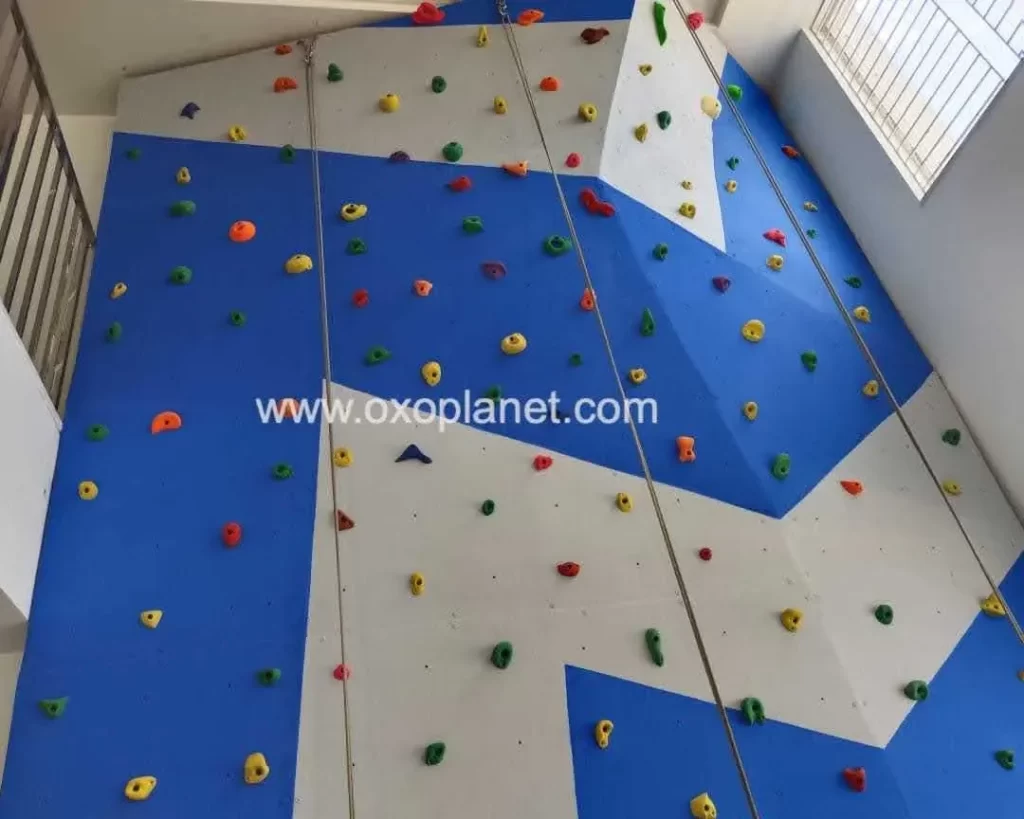
Outdoors Climbing Walls offer their own set of challenges not found when the climber is inside, such as changes in temperature, humidity, climate etc. They are located in an open ground or attached to outside of an existing building structure. Building an outdoor climbing wall is popular amongst schools, adventure parks, competition climbing, army training etc.
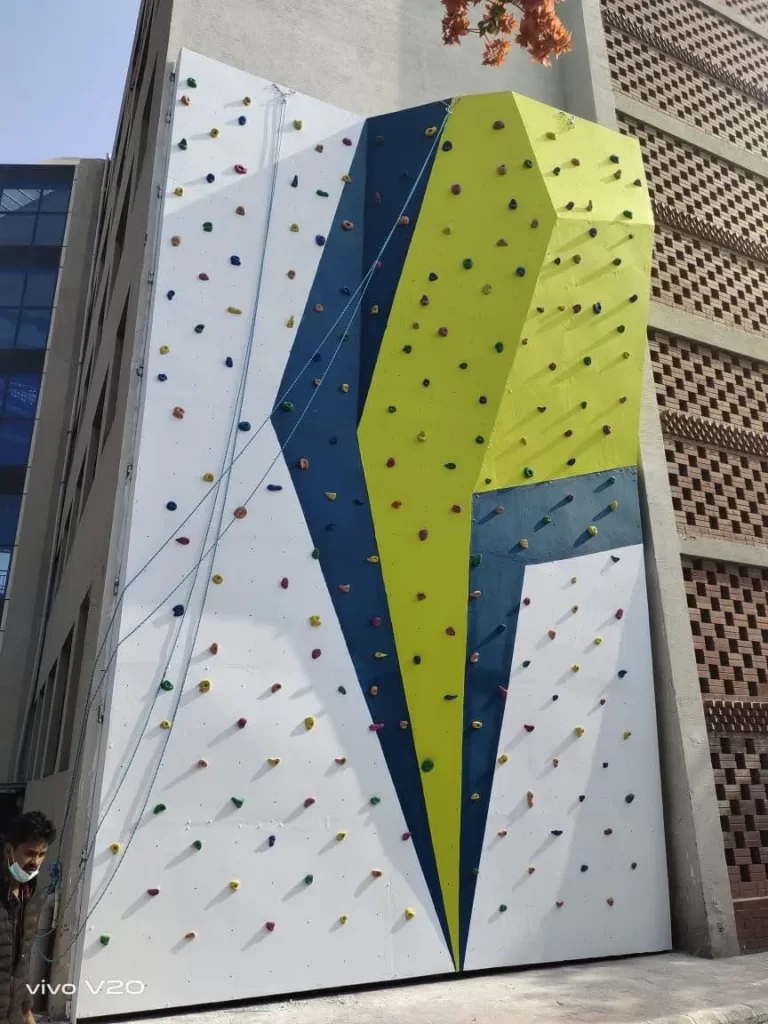
Lead Climbing walls are usually 10 to 15 meters high with a width of 3 meter to 6 meters. Speed Walls are generally less than 10 or 15 meters high with a width of 4 to 6 meters. Bouldering Walls are the lowest in height, usually less than 4 meters, and have a width of 8 to 12 meters.
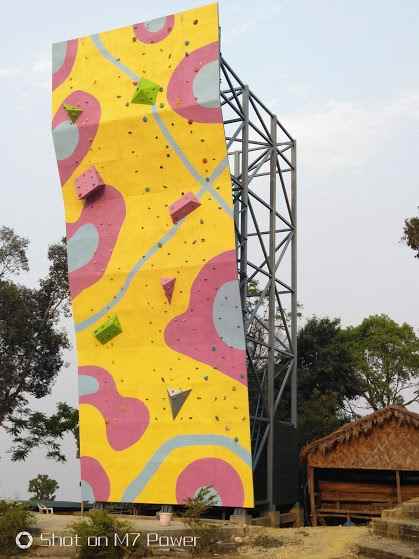
All three types of artificial rock-climbing walls can be built in various surfaces- incline, flat and vertical. The type of surface will determine how intense the climb is.
Speed walls have a typical route as per International Federation of Sport Climbing standards, and they are used mainly for climbing at a higher speed. In addition, bouldering walls usually only require hands to grip the handles, unlike traditional climbing, where climbers also use footholds in addition to handholds.
Finally, artificial rock climbing walls can be placed indoors and outdoors in safe areas where falls do not pose a risk for sports accidents. Climbers should also consider giving routes/problems varying degrees of difficulty by allowing them to reach higher heights with each attempt at ascending the wall.
Fundamentals of artificial rock climbing
The anatomy of an artificial rock climbing wall typically consists of four parts: the wall itself, the roof, the floor and the landing zone. The wall is the part of the wall that climbers use to grip their hands and feet. The top is the part of the wall over the climber’s head, and it is typically angled so that climbers have to use more upper-body strength to ascend it. The floor is the part of the wall at ground level and is generally used as a landing zone for climbers descending the wall. The landing zone is where climbers can safely fall without being injured.
Various types of holds can be found on artificial rock climbing walls. These holds come in multiple shapes and sizes and provide climbers with different challenges. Some of the most common types of holds are crimps, jugs, slopers and pinches.
To help climbers grip, these hold better; many walls are equipped with unique textures. These textures can be made from various materials, including wood, fiberglass and plastic.
The Support Structure of Climbing Wall
The climbing wall has an artificial support structure made of MS or RCC. The floor is usually a square or rectangle platform made of concrete, metal, or plastic. The walls are made of the FRP (Fiberglass Reinforced plastic) or plywood material and are generally between 8 and 12 meters high, although some are as high as 18 meters. The roof is generally a slab of concrete or metal placed above the walls and is used to simulate the overhang of a natural rock face.
Fiber and Wood Panels
The wall is covered in fiber or wood panels. These panels create the surface that the climber will be scaling. The panels are usually placed at a 90-degree angle to replicate the rise of a natural rock face. But they can be placed anywhere between 0 -90 degrees to make climbing more challenging. The Climbing panels can be made from different materials such as plastic, Wood, or fibreglass.
Climbing Holds or Gripping Surfaces
There are three main types of gripping surfaces: handholds, footholds, and cracks. Handholds are protruding objects that climbers use to grip with their hands. Footholds are objects that climbers use to place their feet on. Cracks are small openings in the wall’s surface that climbers use to put their fingers and toes into. These surfaces are usually made out of Wood, plastic, or fiberglass.
Texture
The wall’s texture is important because it determines how easily the climber can grip the surface. The wall can be either smooth or textured. Smooth walls are difficult to grip because there is nothing for the climber to hold onto. Textured walls have a rougher surface that provides more grip for the climber. Generally bouldering walls are smooth and lead walls have texture.
Various types of Climbing Walls– Lead, Speed and Bouldering Walls
There are three main artificial rock-climbing walls: lead, speed, and bouldering. Lead walls are the most common type of wall used for traditional climbing. Speed walls are designed for climbers who want to improve their speed and endurance. Bouldering walls are used for climbing at a lower height.
Lead Wall
A lead wall is an artificial rock-climbing wall used for traditional climbing. It is usually designed with two vertical and horizontal panels to form a rectangular structure. The walls typically range from 8 to 15 meters in height, and the width between the panels ranges from 3 meter to 6 meters. The lead climbing wall consists of holds attached directly onto or into the panel itself. These holds can be made out of different materials such as wood, plastic, FRP etc.
A lead wall has three types of surfaces- a flat one on which a climber stands while they rest between attempts at completing a route or problem/before attempting it again; an inclined surface where climbers will stand and pull themselves up using their hands; and an overhang vertical surface for ascending. This type of artificial rock climbing wall is used mainly for traditional climbing.
- Height: 8 to 15 meters
- Width: 3 meter to 6 meters
- Surfaces: incline, flat, overhang
Speed Climbing Wall- Endurance Climbing
A Speed Climbing Wall is an artificial rock climbing wall that has been explicitly designed for climbers who want to improve their speed and endurance. These walls are usually 10 or 15 meters high and have a very smooth surface. The holds on a Speed Wall are usually very close to each other. The handles are also more extensive than those found on a lead wall due to the lower height of the wall.
- Height: 10 or 15 meters
- Width: 4 to 6 meters
- Surfaces: Vertical
- Hold Material: usually large holds

Bouldering Wall or Traverse Wall – Low Height Climbing Wall
A Bouldering Wall consists of an artificial rock climbing wall that is low in height with a maximum of 4 meters. These walls usually have smaller holds on them, and they are further apart from each other than those on speed climbing walls. Usually, bouldering walls do not require ropes or harnesses because the height of bouldering wall is less. Also, these bouldering walls are usually supported by crash mattresses and spotting by another climber.
- Height: maximum of 4 meters
- Width: usually wider than Speed Walls with a width between 4 and 6 meters
- Surfaces: inclined, flat, overhang
- Hold Material: small and large holds and volumes.
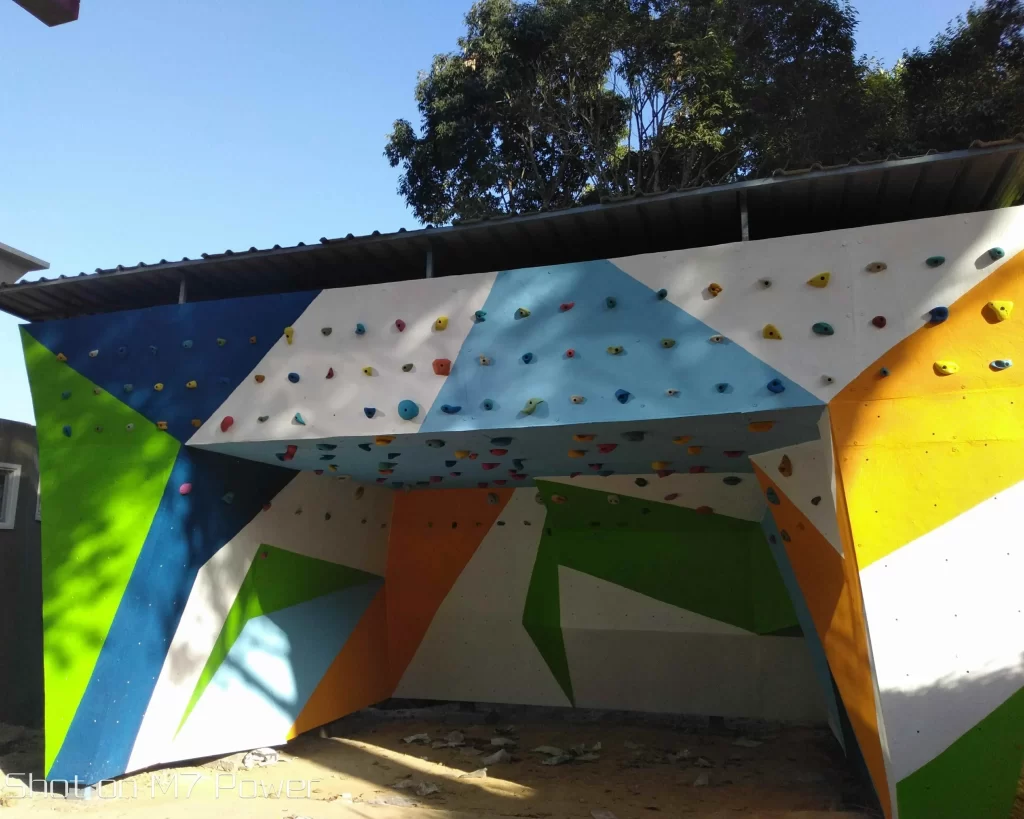
Size Possibilities
Artificial climbing wall dimensions are usually measured in meters. However, depending on the use and level of intensity, bouldering walls can be as short as 2 meters, while lead walls are just over 8 meters tall from ground level. The width of a Speed Wall is usually around 3 meters, while that of a Bouldering Wall is between 4 and 6 meters wide. In addition, when measuring an artificial rock climbing wall’s height, it is critical to measure from the floor.
While there are no guidelines for setting the ideal width for an installation, climbers should take into consideration how much space they need if they plan on using a larger surface area with a more significant number of holds or a smaller size with fewer holds to increase or decrease the level of difficulty, respectively.
Climbing Walls for Exercise, tourism, training, Entertainment, Education
Artificial climbing walls have also been used as training tools since German Kurt Albert and his friends, even before their first appearance in the early 1940s. Today, training on artificial walls has become commonplace because of its popularity, especially among climbers who hope to compete professionally or at higher levels of difficulty. Furthermore, climbers must train regularly with expert supervision provided by trainers or experienced climbers to prevent injuries. Climbing wall gyms are also becoming popular in west and have started coming up in India as well.
In the early 1990s, the first commercial artificial climbing wall was built in the United States, and it became an instant success. Ever since, their popularity has only grown with new designs and more challenging surfaces being developed all the time. In addition, artificial rock climbing walls are now being used for entertainment and education.
Rock climbing in children
Some schools have started incorporating artificial climbing walls into their physical education curriculums to encourage children to be more active. As a result of these different uses, there is no one-size-fits-all design for artificial rock climbing walls – their dimensions can vary depending on their intended function or location.
Artificial climbing walls are used all over the world for different reasons. For instance, exercise is one of the main reasons people install artificial climbing walls in their homes. Climbing is a great full-body workout that requires strength, endurance and flexibility. Rock climbers are known for being the fittest athletes because climbing constantly challenges these fitness aspects.
Climbing Wall as a tourist attraction?
Many people who are not into rock climbing often increase their physical activity once they start climbing regularly. Additionally, as tourism has become more popular, businesses have found artificial rock-climbing walls a great way to bring in people looking for new and exciting activities to do while on vacation.
Many resorts and amusement parks have installed artificial rock-climbing walls to appeal to this market. However, artificial rock-climbing walls are not just for tourists. They are also used for training and as a form of entertainment. Artificial climbing walls are becoming more popular in schools to teach children about rock climbing in a safe and controlled environment. Additionally, many universities have started using artificial rock-climbing walls as part of their physical education curriculum.
Tourism is one of the reasons why many artificial climbing walls are being constructed. Climbing is considered an extreme sport; however, thousands of people are willing to try this challenging sport. Thus, artificial climbing walls make it possible for these enthusiasts to climb without travelling far from their homes to experience a real rock-climbing adventure.
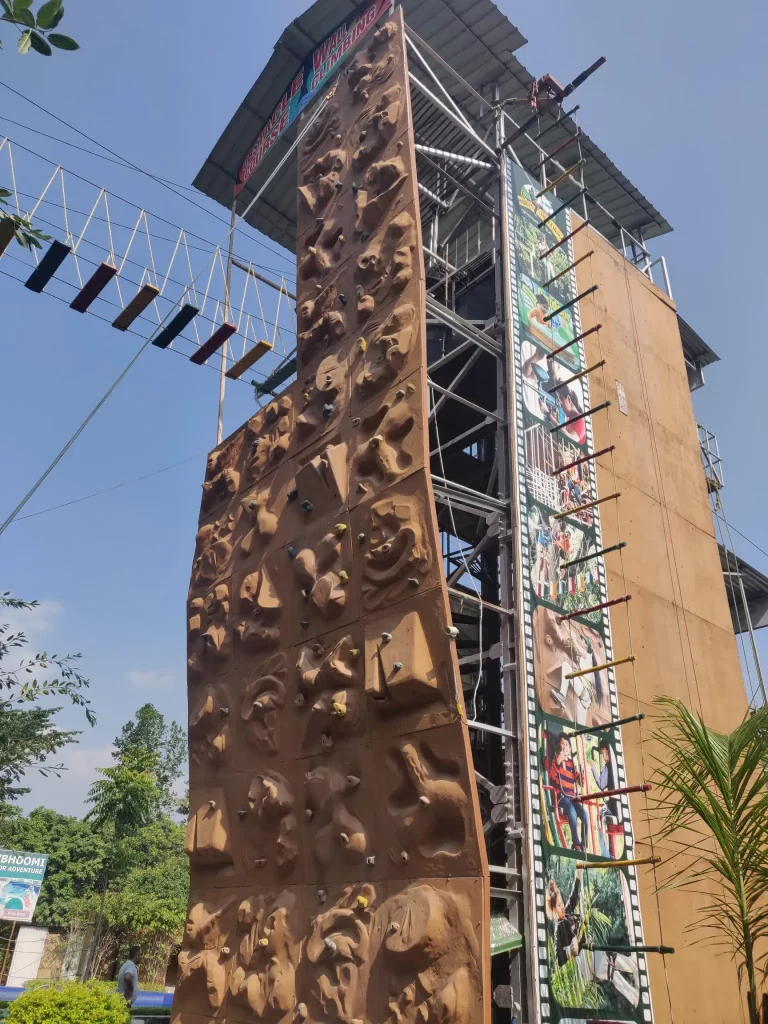
Training for Competitions
Training Centers use climbing walls to train students physically and emotionally for various sports competitions such as the Olympics. In addition, Artificial Climbing Walls are used as an alternative training exercise by those who love climbing but cannot afford to go to actual rock cliffs regularly.
For climbers, artificial climbing walls also provide an opportunity to experience the thrill of rock climbing without dealing with dangerous conditions such as high winds, extreme climates and so forth.
Indoor Parks use artificial climbing walls to allow visitors a chance to enjoy the sport indoor. In addition, these installations provide a good workout for climbers, especially those who are just starting and may not yet feel comfortable with outdoor rock climbing.
A Fun Activity
Many indoor rock-climbing walls are used as places where people can gather together to have fun or as training facilities for professional climbers who want to practice every day. In addition, many hotels feature these installations as amenities for hotel guests to use during their stay. Finally, artificial climbing walls are often installed in schools and daycare centers as part of children’s physical education programs.
Finally, because artificial rock-climbing walls can be commissioned as portable and can be installed indoors or outdoors in safe areas, they provide an excellent option for trying the sport. Still, they don’t have easy access to natural cliffs or rocks.
Conclusion
Artificial rock-climbing walls have been around for over 60 years and, since their invention, the popularity of this sport has continued to grow. Climbing is a great way to exercise, and being able to do so from the comfort of one’s own home is a popular option for many people.
In addition, artificial rock climbing walls are now used as entertainment in resorts, amusement parks and even some universities. They can attract tourists, but they also turn children into climbers by integrating the sport into physical education curriculums. Artificial climbing walls have significantly evolved, with their different designs constantly improving upon what was already there.
Today, using an artificial wall requires more skill than ever before, making this sport more entertaining. Whether for exercise, tourism or education purposes, artificial rock climbing walls are an excellent option for many people. With proper safety precautions in place, there is no reason why anyone should not give this sport a try.
To build a climbing wall, contact best rock climbing wall manufacturers in India Oxo planet

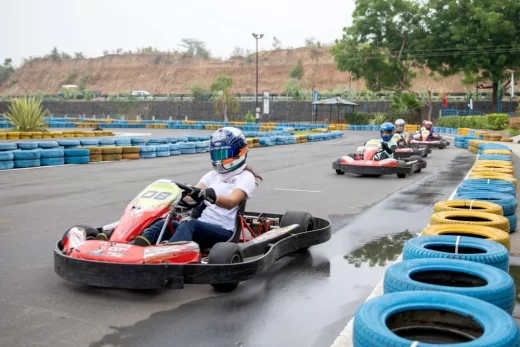
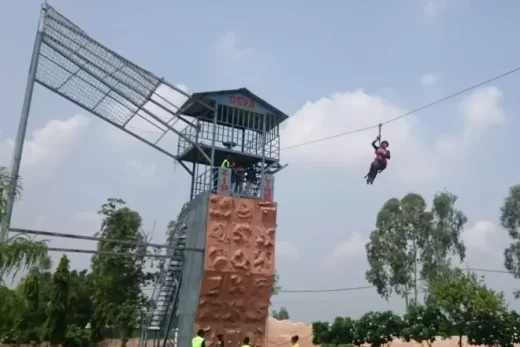
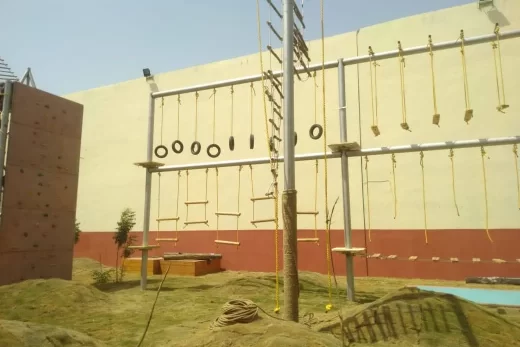
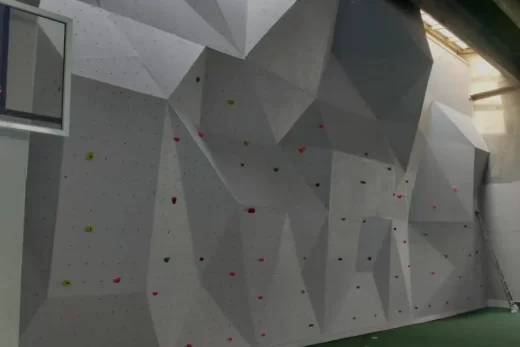
Recent Comments